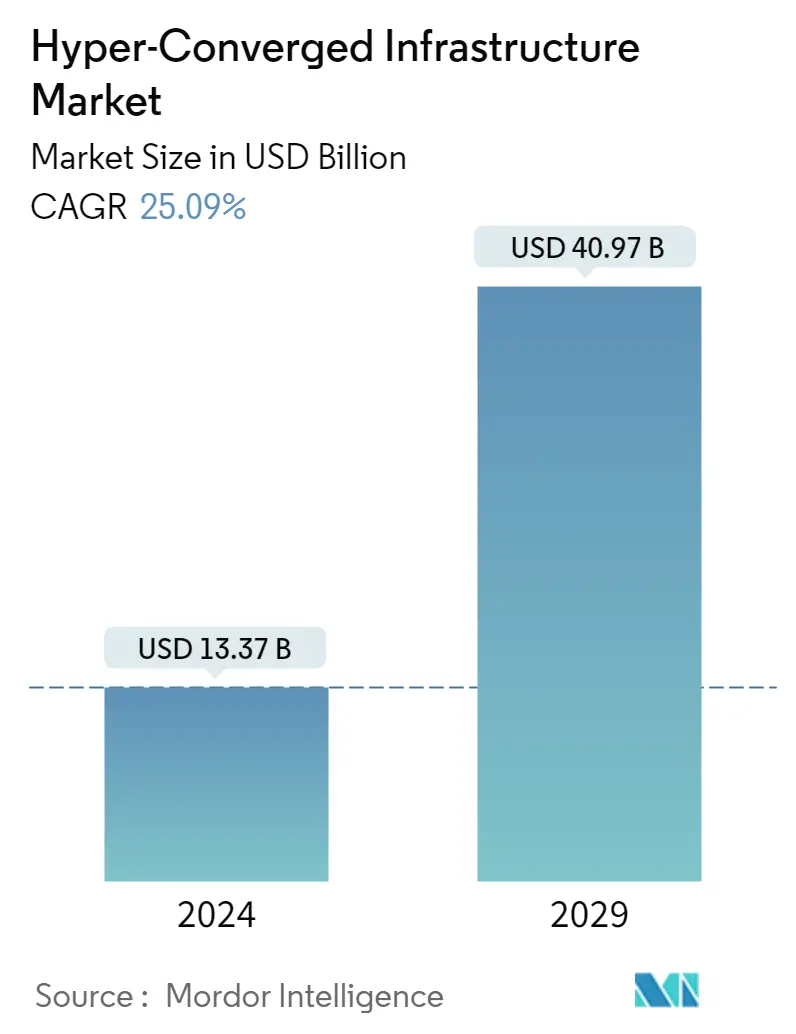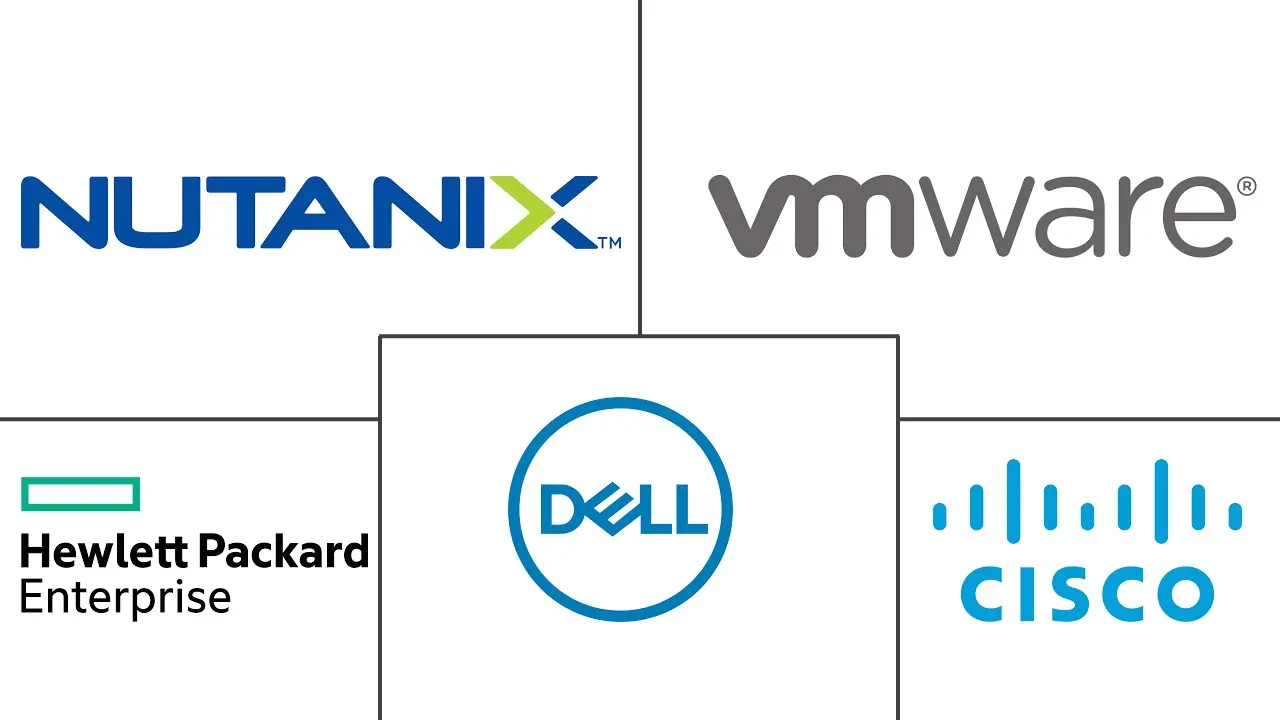Market Size of Hyper-Converged Infrastructure Industry

| Study Period | 2019 - 2029 |
| Market Size (2024) | USD 13.37 Billion |
| Market Size (2029) | USD 40.97 Billion |
| CAGR (2024 - 2029) | 25.09 % |
| Fastest Growing Market | North America |
| Largest Market | Asia-Pacific |
Major Players
*Disclaimer: Major Players sorted in no particular order |
Hyper converged Infrastructure Market Analysis
The Hyper-Converged Infrastructure Market size is estimated at USD 13.37 billion in 2024, and is expected to reach USD 40.97 billion by 2029, growing at a CAGR of 25.09% during the forecast period (2024-2029).
- Hyper-convergence infrastructure (HCI) has emerged as a transformative solution within the IT industry, revolutionizing the way organizations manage their data centers. The market for HCI has experienced significant growth and adoption as businesses seek to streamline their infrastructure, enhance operational efficiency, and embrace digital transformation.
- The increasing adoption of cloud computing has been a major driving factor for the hyper-converged infrastructure market. Enterprises across various industries are shifting their workloads to the cloud to leverage its scalability, cost-effectiveness, and flexibility. HCI solutions complement cloud environments by seamlessly integrating on-premises and cloud resources. With HCI, organizations can easily migrate workloads between private and public clouds, enabling hybrid cloud deployments that combine the benefits of both environments. This synergy between HCI and cloud computing has accelerated the market growth and is expected to continue driving the demand for hyper-converged infrastructure solutions.
- Data center virtualization and consolidation have become imperative for organizations seeking to optimize their IT infrastructure and reduce operational costs. Hyper-converged infrastructure offers a consolidated approach to data center management, enabling organizations to combine multiple components into a single, unified system. By leveraging virtualization technologies, HCI enables the efficient allocation and utilization of computing resources, leading to improved performance and reduced hardware footprint. The scalability and flexibility offered by HCI make it an ideal solution for data center consolidation and virtualization initiatives. As a result, the market for hyper-converged infrastructure is experiencing substantial growth driven by the demand for efficient data center operations.
- The global hyper-converged infrastructure market is experiencing increasing demand due to various applications, leading to greater efficiency in IT infrastructure. This surge in demand is fueled by the ability of hyper-converged infrastructure systems to safeguard data within on-premises data centers, offering features such as snapshots, replication, and encryption. Consequently, organizations across various sectors are seeking these solutions.
- However, the high initial investment cost of implementing HCI solutions is hampering the market. While HCI offers numerous benefits, including simplified management, improved scalability, and reduced operational costs, the upfront investment required to deploy these solutions can be significant. The costs of hardware, software licenses, and professional services can be challenging, particularly for small and medium-sized enterprises (SMEs) with limited IT budgets. The high initial investment cost is a barrier to adoption, hindering market growth. However, as the market matures and technology advancements occur, the cost of HCI solutions is expected to decline, making them more accessible to a broader range of organizations.
- The COVID-19 pandemic significantly accelerated digital transformation initiatives across industries. Organizations worldwide realized the importance of agile and resilient IT infrastructure to support remote work, online collaboration, and digital services. Hyper-converged infrastructure enabled these transformations by providing a scalable and flexible infrastructure foundation. The pandemic highlighted the need for businesses to be agile and adaptable, leading to increased adoption of HCI solutions. As a result, the post-COVID-19 era is expected to witness a further boost in the hyper-converged infrastructure market as organizations continue to invest in technologies that enhance their digital capabilities.
Hyper converged Infrastructure Industry Segmentation
Hyperconverged infrastructure (HCI) is a software-defined information technology (IT) infrastructure combining computing, storage, and networking functionalities into a single, integrated system. It is designed to streamline data center operations, simplify management, and enhance scalability and flexibility. HCI offers benefits such as streamlined operations, improved resource utilization, agility, and faster deployment of applications; It is well-suited for virtualized environments, remote offices, and edge computing scenarios.
The scope of the study focuses on the market analysis of hyper-converged infrastructure solutions. Market sizing encompasses the revenue generated through hyper-converged infrastructure solutions around the globe sold by various market players. The study also tracks the key market parameters, underlying growth influencers, and major vendors operating in the industry, which supports the market estimations and growth rates during the forecast period. The Hyper-Converged Infrastructure Market is segmented by Service (Professional, Managed), by Organization Type (Large Enterprise, Small & Medium Enterprise), by End-user Industry (IT & Telecommunication, BFSI, Healthcare, Retail, Government and Defense), and by Geography (North America, Europe, Asia-Pacific, Latin America, and Middle East & Africa).
The market sizes and forecasts are provided in terms of USD value for all the above segments.
| By Service | |
| Professional | |
| Managed |
| By Organization Type | |
| Large Enterprise | |
| Small & Medium Enterprise |
| By End-user Industry | |
| IT & Telecommunication | |
| BFSI | |
| Healthcare | |
| Retail | |
| Government and Defence | |
| Other End-user Industries |
| Geography | |
| North America | |
| Europe | |
| Asia-Pacific | |
| Rest of the World |
Hyper-Converged Infrastructure Market Size Summary
The hyper-converged infrastructure (HCI) market is experiencing robust growth, driven by the increasing need for organizations to streamline their IT operations and enhance digital transformation efforts. HCI solutions integrate networking, storage, and computation into a single system, offering a consolidated approach to data center management. This integration is particularly beneficial for enterprises looking to optimize their infrastructure, reduce operational costs, and improve data security. The synergy between HCI and cloud computing has been a significant factor in the market's expansion, as businesses increasingly adopt hybrid cloud deployments that combine on-premises and cloud resources. The COVID-19 pandemic further accelerated the adoption of HCI solutions, as organizations recognized the importance of agile and resilient IT infrastructure to support remote work and digital services.
Despite the high initial investment costs associated with implementing HCI solutions, the market is poised for continued growth as technology advancements are expected to reduce these costs, making HCI more accessible to a broader range of organizations. The market is moderately competitive, with major players like Nutanix, Dell, VMware, and Cisco Systems dominating the landscape. These companies are actively engaging in partnerships, mergers, and investments to maintain their market positions and expand their offerings. The expansion of hyper-scale cloud service providers, particularly in North America, is also driving market growth, as is the increasing demand for software-defined storage solutions. As enterprises continue to invest in technologies that enhance their digital capabilities, the hyper-converged infrastructure market is set to witness substantial growth in the coming years.
Hyper-Converged Infrastructure Market Size - Table of Contents
-
1. MARKET INSIGHTS
-
1.1 Market Overview
-
1.2 Industry Attractiveness - Porter's Five Forces Analysis
-
1.2.1 Bargaining Power of Buyers/Consumers
-
1.2.2 Bargaining Power of Suppliers
-
1.2.3 Threat of New Entrants
-
1.2.4 Threat of Substitute Products
-
1.2.5 Intensity of Competitive Rivalry
-
-
1.3 Impact of COVID-19 on the Market
-
-
2. MARKET SEGMENTATION
-
2.1 By Service
-
2.1.1 Professional
-
2.1.2 Managed
-
-
2.2 By Organization Type
-
2.2.1 Large Enterprise
-
2.2.2 Small & Medium Enterprise
-
-
2.3 By End-user Industry
-
2.3.1 IT & Telecommunication
-
2.3.2 BFSI
-
2.3.3 Healthcare
-
2.3.4 Retail
-
2.3.5 Government and Defence
-
2.3.6 Other End-user Industries
-
-
2.4 Geography
-
2.4.1 North America
-
2.4.2 Europe
-
2.4.3 Asia-Pacific
-
2.4.4 Rest of the World
-
-
Hyper-Converged Infrastructure Market Size FAQs
How big is the Hyper-Converged Infrastructure Market?
The Hyper-Converged Infrastructure Market size is expected to reach USD 13.37 billion in 2024 and grow at a CAGR of 25.09% to reach USD 40.97 billion by 2029.
What is the current Hyper-Converged Infrastructure Market size?
In 2024, the Hyper-Converged Infrastructure Market size is expected to reach USD 13.37 billion.

